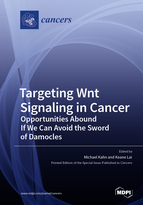Targeting Wnt Signaling in Cancer: Opportunities Abound If We Can Avoid the Sword of Damocles
A special issue of Cancers (ISSN 2072-6694). This special issue belongs to the section "Molecular Cancer Biology".
Deadline for manuscript submissions: closed (31 May 2021) | Viewed by 53761
Special Issue Editors
Interests: Wnt signaling; differential Kat3 coactivator usage; stem cells and cancer stem cells; aging; chemical genomics
Special Issues, Collections and Topics in MDPI journals
Interests: Wnt signaling; cancers of liver and pancreas; metabolism; fibrosis
Special Issues, Collections and Topics in MDPI journals
Special Issue Information
Dear Colleagues,
In the “Topic of Special Interest”, we propose to cover the role of Wnt signaling in cancer, likely with a focus on cancers in solid tumors, especially GI cancers. We will discuss the different driver mutations associated with Wnt-driven cancers (i.e., APC, beta-catenin, Axin, RNF43, etc.) and their association with various cancer types. We plan to also discuss the role of Wnt signaling on the tumor microenvironment and the tumor immune response. Finally, a discussion of efforts to pharmacologically target Wnt signaling to date, including problems and progress, is planned.
Prof. Michael Kahn
Dr. Keane Lai
Guest Editors
Manuscript Submission Information
Manuscripts should be submitted online at www.mdpi.com by registering and logging in to this website. Once you are registered, click here to go to the submission form. Manuscripts can be submitted until the deadline. All submissions that pass pre-check are peer-reviewed. Accepted papers will be published continuously in the journal (as soon as accepted) and will be listed together on the special issue website. Research articles, review articles as well as short communications are invited. For planned papers, a title and short abstract (about 100 words) can be sent to the Editorial Office for announcement on this website.
Submitted manuscripts should not have been published previously, nor be under consideration for publication elsewhere (except conference proceedings papers). All manuscripts are thoroughly refereed through a single-blind peer-review process. A guide for authors and other relevant information for submission of manuscripts is available on the Instructions for Authors page. Cancers is an international peer-reviewed open access semimonthly journal published by MDPI.
Please visit the Instructions for Authors page before submitting a manuscript. The Article Processing Charge (APC) for publication in this open access journal is 2900 CHF (Swiss Francs). Submitted papers should be well formatted and use good English. Authors may use MDPI's English editing service prior to publication or during author revisions.
Keywords
- Wnt
- GI cancers
- tumor metabolism
- tumor microenvironment and tumor immune response







